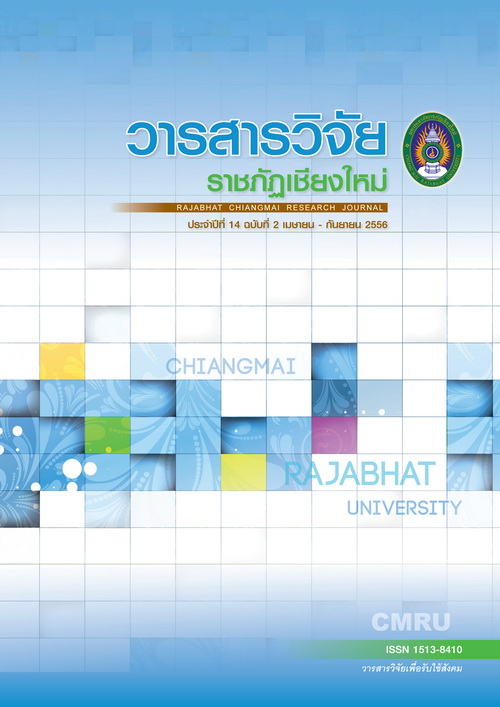การพัฒนาคุณภาพการจัตการเรียนรู้ ที่เน้นผู้เรียนเป็นสำคัญโดยใช้สื่อเทคโนโลยี
DOI:
https://doi.org/10.14456/rcmrj.2013.96152Keywords:
การเรียนรู้ที่เน้นผู้เรียนเป็นสำคัญ, สื่อเทคโนโลยี, Child-centered approach, Media technologyAbstract
การวิจัยในครั้งนี้มีวัตถุประสงค์เพื่อ 1) ศึกษาสภาพปัญหาและความต้องการในการจัดการเรียนร้ที่เน้นผู้เรียนเป็นสำคัญโดยใช้สื่อเทคโนโลยี 2) พัฒนาครูด้านการจัดการเรียนร้ที่เน้นผ้เรียนเป็นสำคัญโดยใช้สื่อเทคโนโลยี และ 3) ศึกษาผลการจัดการเรียนรู้ที่เน้นผู้เรียนเป็นสำคัญโดยใช้สื่อเทคโนโลยี กลุ่มเป้าหมายคือ โรงเรียนวัดช่างเคี่ยน อำเภอเมืองเชียงใหม่ จังหวัดเชียงใหม่ โดยมืผู้ให้ข้อมูลหลักคือ ครู ผู้บริหาร นักเรียน ผู้ปกครอง และคณะกรรมการสถานศึกษาขั้นพื้นฐาน เครื่องมือที่ใช้ในการวิจัยคือ แบบวิเคราะห์เอกสาร แบบสังเกต แบบสัมภาษณ์ แนวทางการระดมสมอง คู่มือการพัฒนาครู แบบทดสอบและแบบสอบถามความพึงพอใจ วิเคราะห์ข้อมูลใช้ค่าร้อยละ ค่าเฉลี่ย ค่าเบี่ยงเบนมาตรฐาน แล้วนำเสนอผลวิจัยโดยใข้วิธีการพรรณนาวิเคราะห์ ผลการวิจัยสรุปได้ ดังนี้
สภาพปัญหาและความต้องการในการพัฒนาคุณภาพการจัดการเรียนรู้ที่เน้นผู้เรียนเป็นสำคัญโดยใช้สื่อเทคโนโลยีดำเนินการโดยวิเคราะห์เอกสาร สัมภาษณ์ผู้บริหารสถานศึกษา และระดมสมองจากครู นักเรียน ผู้ปกครอง และคณะกรรมการสถานศึกษาขั้นพื้นฐาน พบว่านักเรียนมีผลสัมฤทธึ๋ทางการเรียนตากว่าเป้าหมายที่ตั้งไว้ ครูยังคงจัดกิจกรรมการเรียนการสอนที่ไม่สอดคล้องกับความต้องการของนักเรียน ครูไม่ใช้เทคโนโลยีในกระบวนการเรียนการสอน ผู้ปกครองนักเรียน และคณะกรรมการสถานศึกษาขั้นพื้นฐานต้องการให้นักเรียนเรียนโดยใช้สื่อเทคโนโลยี
การพัฒนาครูด้านการจัดการเรียนรู้ที่เน้นผู้เรียนเป็นสำคัญโดยใช้สื่อเทคโนโลยี โดยการจัดประชุมเชิงปฏิบัติการจำนวน 6 ครั้ง ดังนี้ 1) การวางแผนการวิเคราะห์ผ้เรียนเพื่อออกแบบการจัดการเรียนรู้ 2) การออกแบบหน่วยการเรียนรู้ที่เน้นผู้เรียนบเป็นสำคัญโดยใช้สื่อเทคโนโลยี 3) การสร้างสื่อมัลติมืเดีย 4) การสร้างหนังสืออิเล็กทรอนิกส์ 5) การผลิตบทเรียนคอมพิวเตอร์ช่วยสอน 6) การหาประสิทธิภาพของแผนการจัดการเรียนรู้ แบบทดสอบก่อนเรียนหลังเรียนและสื่อเทคโนโลยีที่ครูสร้าง ปรากฎผลการพัฒนาดังนี้ 1) ครูมีความรู้ ความเช้าใจในการจัดทำแผนการจัดการเรียนรู้และสร้างสื่อเทคโนโลยี เพื่อพัฒนาคุณภาพการจัดการเรียนรู้ที่เน้นผู้เรียนเป็นสำคัญโดยมีคะแนนเฉลี่ยแบบทดสอบหลังการประชุมเชิงปฏิบัติการ สูงกว่าก่อนการประชุมเชิงปฏิบัติการคิดเป็นร้อยละ 30.53 2) พฤติกรรมของครูมีความกระตือรีอร้น มีความตั้งใจ และสนใจในการเช้าร่วมประชุมเชิงปฏิบัติการเพื่อพัฒนาคิรุณภาพการจัดการเรียนรู้ที่เน้นผู้เรียนเป็นสำคัญ 3) ความพึงพอใจของครูต่อการพัฒนาครูด้านการจัดการเรียนรู้ที่เน้นผู้เรียนเป็นสำคัญโดยใช้สื่อเทคโนโลยีในภาพรวมอยู่ในระดับมากที่สุด มีค่าเฉลี่ยเท่ากับ 4.57 รองลงมาคือด้านนโยบายและการบริหารจัดการ และด้านการพัฒนาคุณภาพการจัดการเรียนเรียนรู้ มีค่าเฉลี่ยเท่ากับ 4.52 และ 4.49 ตามลำดับ
หลังจากพัฒนาครูด้านการจัดการเรียนรู้ที่เน้นผู้เรียนเป็นสำคัญโดยใช้สื่อเทคโนโลยี ครูได้นำสื่อเทคโนโลยีไปจัดการเรียนรู้ให้แก่ผู้เรียน ปรากฏผลดังนี้ 1) ผู้เรียนมีคะแนนร้อยละความก้าวหน้าของผลสัมฤทธึ๋ทางการเรียนของนักเรียนก่อนและหลังเรียนโดยใช้สื่อเทคโนโลยีอยู่ระหว่าง 12.60-79.00 2) ผู้เรียนมีความคิดเห็นว่าการจัดการเรียนรู้ที่เน้นผู้เรียนเป็นสำคัญโดยใช้สื่อเทคโนโลยีช่วยให้ผู้เรียนมีส่วนร่วมในการวางแผน เลือก สร้าง และใช้สื่อการเรียนการสอนทางเทคโนโลยีในการจัดกิจกรรมการเรียนรู้ ผู้เรียนสามารถเรียนรู้ด้วยตนเอง มีการศึกษาค้นคว้าและอภิปรายกลุ่มทำให้บรรยากาศในการเรียนมีความสนุกสนาน ตื่นตัวอยู่ตลอดเวลาไม่น่าเบื่อ ส่งผลให้มีผลลัมฤทธึ๋ทางการเรียนสูงขึ้น และสามารถในไปใช้ในชีวิตประจำวันได้
THE DEVELOPMENT OF LEARNING PROCESS FOR CHILD-CENTERED APPROACH BY USING MEDIA TECHNOLOGY
The purposes of this research were to 1) investigate problem situations and needs for child-centered approach by using media technology; 2) develop teachers for child-centered approach by using media technology; and 3) study research findings in child-centered approach by using media technology. The target group was Watchangkian School, Muang district, Chiang Mai province, where the respondents were its teachers, administrator, students, parents, and basic school committees. The instruments used in the research were text analysis, observation, interviewing, guidelines for brainstorming, a guidebook for teacher development, pretest and posttest, and satisfaction questionnaire. Percentage, mean, and standard deviation were used for data analysis. Descriptive analysis was employed to present its research findings. The findings were summarized as follows:
The problem situations and needs for developing the quality of child-centered approach by using media technology was investigated by analyzing documents, interviewing the school administrator, and brainstorming from the teachers, students, parents, and basic school committees. It was found that the learning achievements of those students were in a lower level than expected. Their teachers had still provided teaching and learning activities with inconsistency in their needs; the teachers had yet to implement such a technology in teaching and learning processes. The basic school committees, parents, and students needed all the learners to learn how to use media technologies in learning process.
The teacher developments of child-centered approach by using media technology were constructed by holding 6 workshop sessions in order to, namely, 1) set an analysis plan for the students involved in designing learning instructions; 2) design a learning module for child-centered approach by using media technology; 3) create multimedia; 4) create e-books; 5) make lessons for computer-assisted instruction; and, 6) determine the effectiveness of learning instructions, pretest and posttest designs, and the media technologies created by the teachers. The developments were shown in the following: 1) the teachers had knowledge and an understanding of making learning instructions and creating media technologies for developing the quality of child-centered approach by using media technology. The average score of their tests administered after attending the workshop sessions was 30.53%, which was higher before holding a workshop session; 2) the teachers’ behaviors were enthusiastic, intent, and interested in attending the workshop sessions for developing the quality of child-centered approach by using media technology; and 3) overall, the average of teachers’ satisfaction on the teacher development of child-centered approach by using media technology was in a high level of 4.57; the average of its policy and administration was in a middle level of 4.52; and, the average of its quality development of learning instructions was in a low level of 4.49, respectively.
After developing the teachers for child-centered approach by using media technology, they implement the media technologies to facilitate learning instructions. The results were shown in the following: 1) the average score of their learning achievements before and after using media technology was 12.60-79.00; and 2) the students gave opinions that the implementation of child-centered approach by using media technology helped them to participate in not only setting the plans, but also using the created and selected media technologies to do learning activities. The students were able to learn by doing researches and joining group discussions. This created the atmosphere of joy, liviliness, and acqusition for their learning and affected their learning achievements in a higher level. The students could apply it to their daily life as well.
Downloads
Downloads
How to Cite
Issue
Section
License
1. Articles, information, content, images, etc published in the “Community and Social Development Journal” are copyrighted by the Community and Social Development Journal, Chiang Mai Rajabhat University. In order to properly distribute the articles through print and electronic media, the authors still hold the copyright for the published articles under the Creative Commons Attribution (CC BY) license, which allows the re-distribution of the articles in other sources. References must be made to the articles in the journal. The authors are responsible for requesting permission to reproduce copyrighted content from other sources.
2. The content of the articles appearing in the journal is the direct responsibility of the article authors. The editorial board of the journal does not necessarily agree with or share any responsibility.














